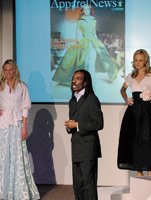FIDM, Annenberg School Event Examines Creativity and Copyright
Innovators in the worlds of fashion, television, music and technology shared the stage at “Ready to Share: Fashion and the Ownership of Creativity,” a day-long conference organized by the Fashion Institute of Design & Merchandising and The Norman Lear Center at the University of Southern California’s Annenberg School for Communication.
Among the speakers at the Jan. 29 event, held on the USC campus, were former Gucci and Yves Saint Laurent Creative Director Tom Ford; New York Times fashion writer Guy Trebay; Los Angeles fashion designer Kevan Hall; retailer and vintage-clothing expert Cameron Silver; pioneering television producer Norman Lear; musicians and producers T-Bone Burnett and Richard Nichols; singer/songwriter Sam Phillips; and John Seely Brown, former chief scientist at Xerox Corp. and director of the Palo Alto Research Center (also known as Xerox PARC).
The music and film industries have been battling to protect their creative properties from infringements such as musicians sampling songs and viewers illegally downloading feature films. But the fashion industry is much more lenient about the appropriation process. Part of the reason is because the laws allow apparel makers to copyright a fabric design as artwork but limit the ability to copyright a complete fashion design.
As a result, copying, borrowing or stealing ideas is fairly common in the apparel industry. The advent of the Internet and the near instantaneous broadcast of fashion trends from the runway to individual’s laptops have contributed to the practice.
“For the last 10 years, as media has sped up, appropriation in every field has become rampant,” said Ford, who, with Trebay, discussed how similar ideas proliferate throughout the fashion industry each season.
This is different from outright copyright infringement, Ford said, relaying a story about his previous employer. Once Gucci, after conducting market research, concluded that the counterfeit customer was very different from the true Gucci customer, the company was less concerned about knockoffs appearing in the marketplace, he said. “Nothing made me happier than to see copies of what I’d done because it meant I’d done it right,” he said.
But some trends seem to magically appear in several designer collections during the same season, thanks in part to designers tapping into the current zeitgeist and in part to gossip within the fashion industry.
“The clues to where you are going to be next year are here now,” Ford explained. “You also have to realize everybody’s assistant is sleeping with everybody else’s assistant and we’re all buying from the same five fabric houses—I hate to demystify it.”
Music in transition
For the music industry, the issue of creativity and ownership is complicated by the prevalence of sampling and the relationships among artists, producers, record labels and retailers, according to members of a panel titled “Handing Down the Song: Music, Ownership & the Creative Process.” The panel was composed of Burnett; Nichols; Phillips; Rani Singh, president of the Harry Smith Archives and a senior research associate at the Getty Research Institute; and Danger Mouse, the creator of “The Grey Album,” which combined The Beatles’ “White Album” and Jay-Z’s “Black Album.”
Phillips used the fashion industry in an analogy, explaining that appropriation within the music industry is similar to combining the top of a stolen Gucci dress with the skirt of a stolen Yohji Yamamoto dress and passing the result off as one’s own design.
That is essentially what Danger Mouse did when he created his album. But the deejay said he made the album as a creative project not a commercial endeavor. It was only after sending a few copies of the album to friends, who then posted the work on the Internet, that “all hell broke loose,” he said.
Broadcasting fashion
The conversation turned to television as writer and producer Lear, best known as the creator of such hit shows as “All in the Family” and “Maude,” and “Sex and the City” scribe Michael Patrick King kicked off a seminar called “The Business of Creativity.”
Both discussed their experiences pushing the boundaries of modern convention on their respective shows, but the conversation soon turned to fashion as King described how actress Sarah Jessica Parker and costume designer Patricia Field helped shape the tone of the show.
King told a story of how a voluminous Versace couture gown became a centerpiece in one of the last episodes, after Parker’s character, Carrie, had moved to Paris. The dress, described as the “1,000-layer gown,” raised a few logistical questions for King, most notably: How could the huge dress have fit into the character’s suitcase?
“Pat Field called me in and said, ’This dress wants to be in the show; do you have anything for it? It came all the way from Europe,’” King said.
Eventually, King relented and wrote the scene around the dress. “Sometimes the fashion and scene go hand in hand, and sometimes the fashion can upstage the words— most of the time it’s like a giant rocket booster,” he said.
Organizers then opened the panel up to include Cate Adair, costume designer for the ABC drama “Desperate Housewives”; Ted Cohen, senior vice president of digital development and distribution at EMI; actress, musician and designer Sheryl Lee Ralph; and Los Angeles Times Fashion Critic Booth Moore.
Tech-assisted trends
Digital technology has facilitated collaboration between the fashion, music and entertainment industries, allowing instant global communications at the click of a mouse. But the power of technology has also created an openness that can stifle creativity. Anyone’s work is up for grabs. It’s a dilemma that is forcing designers, musicians and artists to ponder how to use communication tools.
Technology and fashion experts Seely Brown, Jonathan Taplin, Siva Vaidhyanathan and David Wolfe addressed how digital communication has been a double-edged sword for the creative industries.
Seely Brown said the advent of the blog world has created legions of “niche communities” and has fostered research and advancements for various industries. With more than 8 million bloggers logging onto the Internet daily, these niche communities have created an open-source software structure and a globally savvy consumer.
That has translated into a worldly view of fashion that has made it more difficult to define what is mainstream, said trend expert Wolfe. “When one in 25 women buy a poncho, they call it a trend. I don’t think so,” he said.
Music industry veteran Taplin said consumers do not want to be sold to anymore; they want to make their own decisions on what fashion, music and television programs to watch. “We’ve transitioned from a world of scarcity. Now, scarcity is not an issue,” he said.
The panelists pointed out that while the Internet has helped young designers gain visibility, it has also allowed larger companies with resources to knock off competitors and make the real money.
History and homage
The conference also included a series of informal fashion shows that examined the fine line between inspiration and imitation.
Designer Hall and FIDM curator Kevin Jones discussed Hall’s current collection, which was inspired by 20th century society icon and jewelry designer Millicent Rogers. The designer presented a series of dresses that recalled classic 1950s coat dresses, Madeleine Vionnet’s bias-cut gowns and Rogers’ understated, elegant style.
Hall said Rogers is always an inspiration for his work. “For this collection, I was waiting for the right moment to pull in her look,” he said.
Silver, owner of Los Angeles upscale vintage boutique Decades and co-owner of vintage and contemporary boutique Decades Two, discussed the evolution of the Chanel jacket and its many imitators in a fashion presentation titled “Chanel or Faux-nel? A Legendary Jacket hellip; Unraveled.”
The retailer and vintage expert discussed the history of the jacket and its reinterpretation under Chanel’s current designer, Karl Lagerfeld. The boxy tweed classic with patch pockets and gold-chain trim began inspiring imitators back in the 1960s, when St. John Knits began making a similar style in the company’s signature knit fabric. Seventies label Adolfo attracted the attention of the French design house when it began referring to its style as “Chanellike,” Silver said. When Lagerfeld took over at Chanel, he deconstructed the jacket, giving it its now-familiar frayed edges. Silver noted that other designer lines— including Marc Jacobs, Comme Des Garcons and Junya Watanabe—have shown their own versions of the tweed jacket. He added that Los Angeles–based contemporary label True Meaning is on track to earn $20 million in sales this year, thanks in part to its own version of the style.
To bring his point home, Silver brought out five models, each wearing a different variation of the jacket, and then invited Lear onstage to identify the designers behind the looks, which featured one classic Chanel, one Lagerfeld-designed Chanel, a St. John version, a vintage Adolfo and the current True Meaning style.
Rose Apodaca, West Coast bureau chief for Women’s Wear Daily, illustrated the importance of the T-shirt and its place in American culture in the final seminar of the day. The lecture, titled “Out on Top: The T-shirt, From Fashion Essential to Revolutionary Icon,” traced the history of the comfortable basic. A slide show illustrated the T-shirt’s evolution from a functional undergarment to a symbol of the American war hero to a uniform for the counterculture and, most recently, to its current fashion status.
T-shirts are used to make political statements, as a platform for rebellion and as a way of identifying membership in a group, Apodaca said. Indeed, there is now such a cult following for T-shirts that people are willing to pay a premium for limited editions and rock ’n’ roll tees, which sell for as much as $950, she continued.
The T-shirt has become a statement for creativity, commerce and fashion and has been reworked in more ways than any other piece of clothing, she said.
Firsts and Fakes
The notion of fashion “knockoffs” is not new, but the practice was pushed into high gear by the baby boomer generation, according to David Wolfe, creative director of the New York–based Donegar Group, who discussed current trends and their origins.
Prior to the 1960s, Parisian couturiers such as Christian Dior decreed everything from the colors to the cut of each season’s fashions. But the swinging London scene of the 1960s sparked a fashion revolution during which youth street fashion captured the world’s attention and inspired designer lines. Pioneering designers such as Kenzo Takeda helped usher in modern fashion, in which unpredictable trends and media events dominate style.
aby boomers should continue to have a heavy influence in fashion this year and beyond, Wolfe said. America’s boomers maintain a deep interest in looking youthful and reward designers who make clothes for them. “Fashion is in extreme makeover,” Wolfe said.
The boomers and the rest of the fashion public have been saturated by flashy celebrity-driven lines, said Wolfe, who predicted that consumers will soon embrace the understated elegance of Audrey Hepburn and Jackie Kennedy in a style that he called “deluxe minimalism.” Natural materials and looks will also gain popularity in a world increasingly devoted to technology, he noted.
























